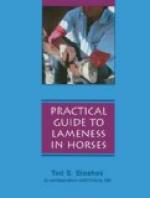Anatomy.—The carpal bones as they articulate with one another and with the radius and metacarpal bones, as classed by anatomists, form three distinct articular parts of the joint as a whole and are known as radiocarpal, intercarpal and carpometacarpal. These three pairs of articulating surfaces are all enclosed within one capsular ligament. On the anterior face of the bones, the capsular ligament is attached to the carpal bones in such manner that an imperfect partitioning of the three joint compartments is formed. Posteriorly, the capsule is very heavy and forms a sort of padding over the irregular surfaces of the bones, and also its reflexions constitute the sheaths of the flexor tendons. The anterior portion of the capsular ligament forms sheaths for the extensor tendons, and both portions of the joint have an attachment around the distal end of the radius and another at the proximal end of the metacarpal bones.
[Illustration: Fig. 13—Carpal exostosis in aged horse.]
Etiology and Occurrence.—Puncture wounds of any kind may serve to perforate the joint capsule and such traumatisms are occasioned by falls, kicks and in various ways in runaway accidents, and open carpal joint may follow.
Symptomatology.—The pathognomonic symptoms of the existence of an open joint is the exposure to view of articular surfaces of bones or noting the escape of synovia from the joint capsule. As has been previously referred to, there always exists a peculiar suspension of carpal flexion in all cases of carpitis.
Non-infective wounds which may cause open joint are not necessarily productive of an active carpitis—a synovitis may be the extent of the disturbance. Unlike synovitis, which may characterize a non-infectious penetrative wound of the capsular ligament, septic arthritis which may supervene is a very painful inflammatory disturbance. It is characterized by all of the symptoms which attend the case of open joint and synovitis plus the obvious manifestation of great pain. There is an elevation of temperature of from two to five degrees above normal; circulation is accelerated; the pulse is bounding; respiration is hurried; there is an expression of pain as indicated by the physiognomy; and because of rapid erosive changes of cartilages which take place, there is soon so much of the articulation destroyed that death is inevitable. Death is usually due to generalization of the arthritic infection.
[Illustration: Fig. 14—Exostosis of carpus resultant from carpitis.]
[Illustration: Fig. 15—Distal end of radius. Illustrating the effects of chronic carpitis.]




